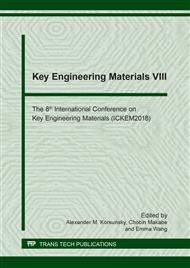[1]
R. Hao, H. Lan, C. Kuang, H. Wang, L. Guo, Superior potassium storage in chitin-derived natural nitrogen-doped carbon nanofibers, Carbon N. Y. 128 (2018) 224–230.
DOI: 10.1016/j.carbon.2017.11.064
Google Scholar
[2]
D.B. Thakur, R.M. Tiggelaar, J.G.E. Gardeniers, L. Lefferts, K. Seshan, Carbon nanofiber based catalyst supports to be used in microreactors: Synthesis and characterization, Chem. Eng. J. 160 (2010) 899–908.
DOI: 10.1016/j.cej.2010.01.005
Google Scholar
[3]
X. Gao, G. Liu, Q. Wei, G. Yang, M. Masaki, X. Peng, R. Yang, N. Tsubaki, Carbon nanofibers decorated SiC foam monoliths as the support of anti-sintering Ni catalyst for methane dry reforming, Int. J. Hydrogen Energy. 42 (2017) 16547–16556.
DOI: 10.1016/j.ijhydene.2017.05.164
Google Scholar
[4]
W.K. Chee, H.N. Lim, Z. Zainal, I. Harrison, Y. Andou, N.M. Huang, M. Altarawneh, Z.T. Jiang, Electrospun graphene nanoplatelets-reinforced carbon nanofibers as potential supercapacitor electrode, Mater. Lett. 199 (2017) 200–203.
DOI: 10.1016/j.matlet.2017.04.086
Google Scholar
[5]
J. Yan, J.H. Choi, Y.G. Jeong, Freestanding supercapacitor electrode applications of carbon nanofibers based on polyacrylonitrile and polyhedral oligomeric silsesquioxane, Mater. Des. 139 (2018) 72–80.
DOI: 10.1016/j.matdes.2017.10.071
Google Scholar
[6]
S. a. Manafi, S.H. Badiee, Production of Carbon Nanofibers Using a CVD Method with Lithium Fluoride as a Supported Cobalt Catalyst, Res. Lett. Mater. Sci. 2008 (2008) 1–5.
DOI: 10.1155/2008/850975
Google Scholar
[7]
S. Arbab, A. Teimoury, H. Mirbaha, D.C. Adolphe, B. Noroozi, P. Nourpanah, Optimum stabilization processing parameters for polyacrylonitrile-based carbon nanofibers and their difference with carbon (micro) fibers, Polym. Degrad. Stab. 142 (2017).
DOI: 10.1016/j.polymdegradstab.2017.06.026
Google Scholar
[8]
S.N. Arshad, M. Naraghi, I. Chasiotis, Strong carbon nanofibers from electrospun polyacrylonitrile, Carbon N. Y. 49 (2011) 1710–1719.
DOI: 10.1016/j.carbon.2010.12.056
Google Scholar
[9]
S. Rafiei, B. Noroozi, S. Arbab, A.K. Haghi, Characteristic assessment of stabilized polyacrylonitrile nanowebs for the production of activated carbon nano-sorbents, Chinese J. Polym. Sci. (English Ed. 32 (2014) 449–457.
DOI: 10.1007/s10118-014-1410-4
Google Scholar
[10]
N. Hameed, J. Sharp, S. Nunna, C. Creighton, K. Magniez, P. Jyotishkumar, N. V. Salim, B. Fox, Structural transformation of polyacrylonitrile fibers during stabilization and low temperature carbonization, Polym. Degrad. Stab. 128 (2016) 39–45.
DOI: 10.1016/j.polymdegradstab.2016.02.029
Google Scholar
[11]
Q. Duan, B. Wang, H. Wang, Effects of stabilization temperature on structures and properties of polyacrylonitrile (PAN)-based stabilized electrospun nanofiber mats, J. Macromol. Sci. Part B Phys. 51 (2012) 2428–2437.
DOI: 10.1080/00222348.2012.676415
Google Scholar


